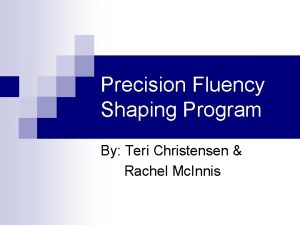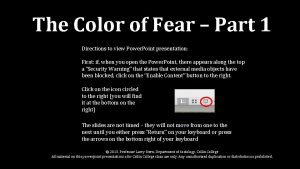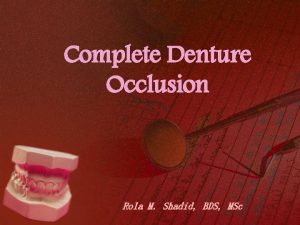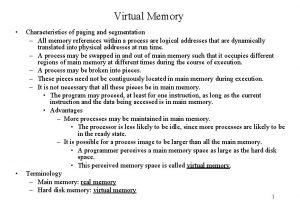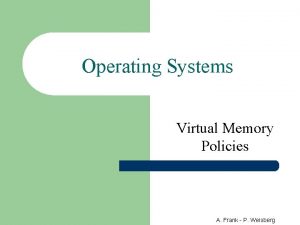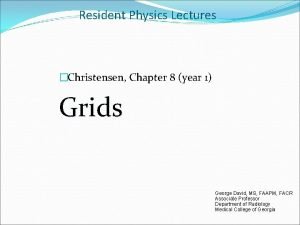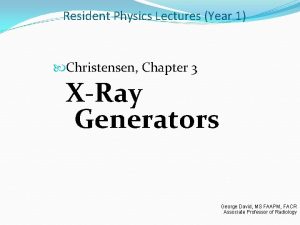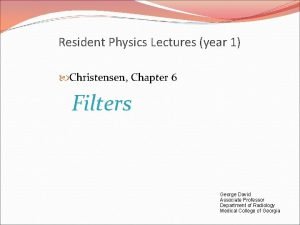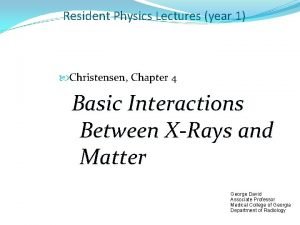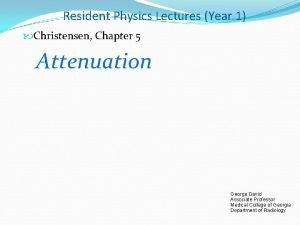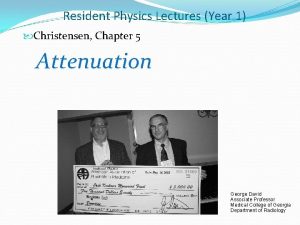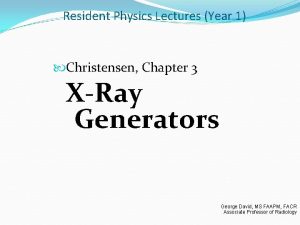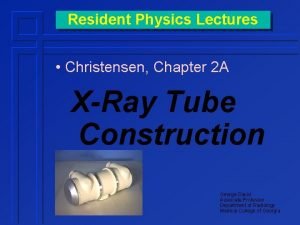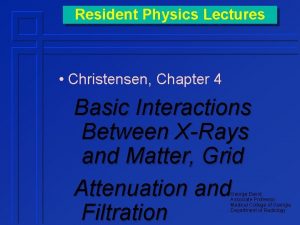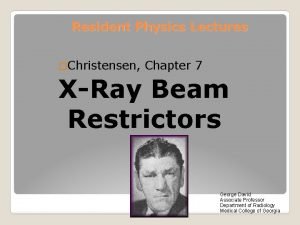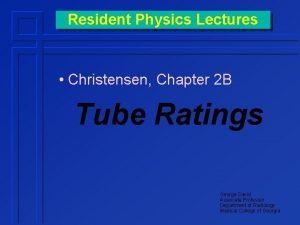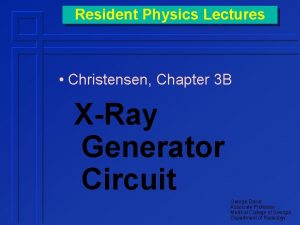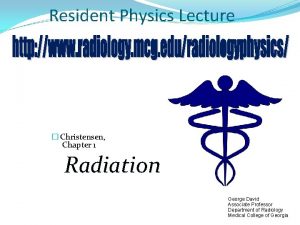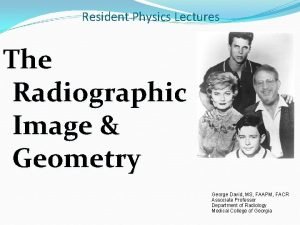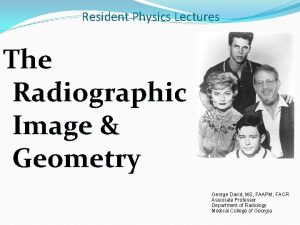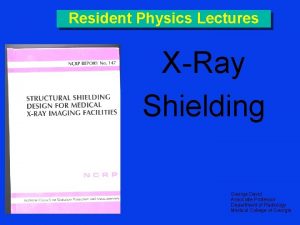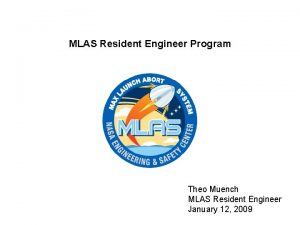Resident Physics Lectures 1 st Year Christensen Chapter



































- Slides: 35

Resident Physics Lectures (1 st Year) �Christensen, Chapter 2 A X-Ray Tube Construction George David Associate Professor Department of Radiology Medical College of Georgia

X-Ray Tube * �Converts Energy �FROM � electrical �To energy � Heat �> 99% of incident energy � X-Rays �< 1% of incident energy � Good! Our desired product

* Heat and X-Ray Tubes �Bad! Ultimately destroys tubes �Limits single exposure beam intensity �Limits ability to make repeated exposures over time

* X-Ray Tube Components �Housing � Visible part of tube �Glass Enclosure (insert) � Vacuum � Electrodes � Cathode � Filament � Anode � Target

* Tube Housing �Shields against leakage radiation �Electrical insulation

Tube Housing Filled with Oil �Helps cool tube �Electrical insulation �Bellows on end of tube allows oil to expand when hot. Insert

Inside the Glass Insert �Filament �Similar to light bulb �Glows when heated �Target �Large (usually) tungsten block target filament

* X-Ray Tube Principle �Filament heated �Electrons released (“boiled” off) �Thermionic emission

X-Ray Tube Principle * + �Positive (high) voltage applied to anode relative to filament � electrons accelerate toward anode target � Gain kinetic energy � electrons strike target � electrons’ kinetic energy converted to � heat � x-rays

Electron Role �Electron carries energy as kinetic energy �Higher energy electron moves faster �Electrons controlled by electric fields �Accelerated �Steered +

Requirements to Produce X-Rays �Filament Voltage �High Voltage anode + high voltage source filament voltage source

Cathode (filament) �Coil of tungsten wire �similar to light bulb filament �Cathode is source of electrons �filament heated by electric current

X-Ray Production(cont. ) �X-Rays produced by 2 distinct processes �Characteristic radiation �Bremsstrahlung

Characteristic Radiation Interaction of high speed incident electron with orbital electron of target �#1: Electron from filament removes inner-shell orbital electron from atom L �#2: electrons from higher energy shells cascade down to fill vacancies �#3: characteristic x-ray emitted #1 + ~ + - Electron from Filament K - #2 ~ - #3

Characteristic Radiation �Consists only of discrete x-ray energies �Energies correspond to difference between electron shells of target atom �Specific energies characteristic of target material L K ~ + + ~ - - - # Energy

Bremsstrahlung �interaction of �moving electron from filament �nucleus of target atoms �+ nucleus causes moving electron to change speed / direction �Electron slows down (loses kinetic energy) �Energy lost in form of Bremsstrahlung x-ray L K Electron from Filament - ~ + + ~ - -

Bremsstrahlung (cont. ) �Bremsstrahlung means braking radiation �Moving electrons have many Bremsstrahlung interaction � small amount of energy lost with each interaction L K ~ + + ~ - - -

Bremsstrahlung (cont. ) �Random energy loss of moving electron �Depends on � distance from nucleus � charge (Z) of nucleus �Bremsstrahlung Energy Spectrum 0 - peak kilovoltage (k. Vp) applied to x-ray tube �most Bremsstrahlung photons have low energy � Don’t escape tube � easily filtered by tube or filters outside tube # Energy

Output Beam Spectrum �Output photon beam consists of � Characteristic Radiation � characteristic of target material � several discrete energies # � Bremsstrahlung � continuous range of energies � 0 - k. Vp setting � most photons have low energy �Spectrum � depicts fraction of beam at each energy Energy # Energy

Tube Current (m. A) �rate of electron flow from filament to target �Electrons / second � Measured in milliamperes (m. A) �Not the same as filament current +

Exposure Parameters �k. Vp � High voltage applied to x- ray tube �m. A � Rate of electron flow from cathode to anode during exposure �Time � Duration of x-ray exposure �m. As � Product of m. A & time

Beam Intensity �Product of � # photons in beam � Photon energy spectrum �Units � Roentgens (R) per unit time � Measure of ionization rate of air �Depends on � k. Vp � m. A � target material � filtration

Intensity & Technique �Beam intensity proportional to m. A �Beam intensity ~ proportional to k. Vp 2 + high voltage source filament voltage source

Focal Spot �Portion of anode struck by electron stream �Focal spot size affects & limits resolution +

Focal Spots �Most tubes have 2 filaments & thus 2 focal spots �only one used at a time �small focus �improves resolution �large focus �improves heat ratings �Electron beam strikes larger portion of target

Focal Spot Size & Resolution The larger the focal spot the more it will blur a tiny place on the patient.

Larger Focal Spot = Better Heat Ratings Electron beam applies huge amount of heat to target

Larger Focal Spot = Better Heat Ratings The larger the area the electron beam hits, the more intense the beam can be without melting the target

Target Angle �Angle between target & perpendicular to tube axis �Typically 7 – 15 degrees + Target Angle, Q

Line Focus Principle + Target Angle + �Actual (true) focal spot �as seen from filament �Apparent (effective, projected) focal spot �as seen from tube port or patient �Target angled 7 -12 o Actual FS Apparent FS Patient

Target Angle • Large – poorer heat ratings – better field coverage �Small �optimizes heat ratings �limits field coverage Large Target Angle (Small Actual Focal Spot) + Small Target Angle (Large Actual Focal Spot) + Same Apparent Focal Spot Size

Heel Effect �Intensity of x-ray beam significantly reduced on anode side �beam goes through more target material exiting anode on anode side x anode side - - cathode side

�Stationary Anodes �Rotating � Target is annular track � spreads heat over large area of anode � speeds � � 3600, 9600 rpm Faster = better heat ratings

Rotating Anode �Advantages �better heat ratings �Disadvantages �More complex ($) � Rotor drive circuitry � motor windings in housing � bearings in insert

Rotating Anode �Larger diameter � Better heat ratings � Heavier � $$$ �Materials � usually tungsten
 Yelena bogdan
Yelena bogdan Ota resident lectures
Ota resident lectures Frcr physics lectures
Frcr physics lectures Frcr physics lectures
Frcr physics lectures Describe the care team and the chain of command
Describe the care team and the chain of command Steep incisal guidance
Steep incisal guidance Teri christensen
Teri christensen Martin juul christensen
Martin juul christensen Oryantasyon düzlemi
Oryantasyon düzlemi David christensen color of fear
David christensen color of fear Tommy christensen gu
Tommy christensen gu Lingualized occlusion advantages
Lingualized occlusion advantages Gerald barnbaum
Gerald barnbaum Dani christensen
Dani christensen Poem leaving school
Poem leaving school Resident set management
Resident set management Resident retention
Resident retention The working set strategy
The working set strategy Means
Means Divine intervention usmle
Divine intervention usmle Resident lifecycle
Resident lifecycle Attending vs resident
Attending vs resident Misappropriation of resident property
Misappropriation of resident property Chapter 19 confusion dementia and alzheimer's disease
Chapter 19 confusion dementia and alzheimer's disease Ambulated side
Ambulated side Partially resident textures
Partially resident textures Acgme resident survey
Acgme resident survey Employment of non-resident aliens in the philippines
Employment of non-resident aliens in the philippines Orientation and resident rights quiz
Orientation and resident rights quiz Customer service conflict resolution
Customer service conflict resolution Define resident flora
Define resident flora Magic mask
Magic mask Resident assessment instrument definition
Resident assessment instrument definition Tarrytown chief resident conference
Tarrytown chief resident conference Resident alien telluride
Resident alien telluride Resident and family engagement
Resident and family engagement






